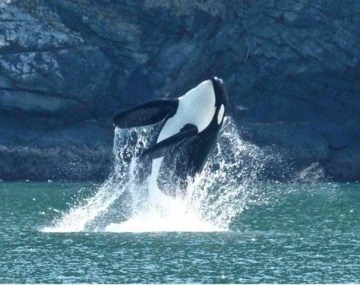July was another superlative month for killer whale watching kayak tours in the San Juan Islands, near Seattle, Washington. Orca whale encounters typically reach their peak in July and the weather is usually fantastic, too. This July did not disappoint – less than ½ of rain fell and high temperatures ranged in the 60-70s. Our out-of-state guests found welcome relief on their Friday Harbor kayaking vacations.
Orca whales were sighted by biologists in the San Juan Islands on all 31 days of July 2011. Killer whales move rapidly and are sometimes very unpredictable, so we didn’t find them every day on our kayak tours. We had our share of bad whale watching luck despite our best efforts. When we missed them, they were often heartbreakingly just out of sight around an intervening point or had just passed by our location an hour before we arrived! And a couple of days experienced very rough seas that made spotting whales nearly impossible.
- We encountered killer whales on 88% of the camping trips – identical to last July!
- All 5-day San Juan kayak expeditions saw orca whales – again same as last July.
- All but two of the 3-day San Juan kayaking trips had excellent killer whale viewing.
- Every 2-day San Juan Islands kayak tours found the orcas.
- The camping trips saw either Dall’s porpoise or harbor porpoise on all but three tours for a success rate of 82%. The only two camping trips that missed the orcas were able to enjoy porpoises as their consolation. So they saw at least one species of the toothed whale family, even if they were the smallest species!
- The 1-day San Juan kayaking trips succeeded in finding killer whales on 56% of the trips in July. We expected about 10% better results for the day trips but this is where the bad luck bit us.

Here’s some more news about our killer whales in the San Juan Islands from the month of July:
- J-pod spent the entire month in the Salish Sea and this is the orca family group we saw the most on our San Juan Island kayak tours in July.
- K-pod is the orca whale family we typically see the most in July over the previous decades.
- L-pod is the largest killer whale family in the resident community with over 40 members. They spent most of July traveling through the San Juan Islands split into two subgroups.
- Transient orca whales (the marine mammal eating species) were rarely seen as expected. They carefully avoid the resident family pods listed above. With the intense resident orca activity in July, the transients kept a low profile. These two species have not interbred for around 100,000 years so it isn’t likely they will be partying together again soon.
Food for the orca whales has been better than average again this year compared to most of the prior two decades. The North Pacific Ocean continues to be in the coolest part of its decadal cycle and this produces more salmon and higher orca whale fertility compared to warm water years. For instance, 3.9 million sockeye are expected to return to the Fraser River this year, whereas their parental generation that grew up during a warm water period was only 1.5 million strong.
Previous blog entries have discussed the importance of chinook salmon as the primary prey species of the resident-type killer whales. Orca whales largely ignore the other salmon species in favor of the larger and fattier chinook. The spring run of chinook in the Columbia River was about 237,000 compared to the 10 year average of 175,000. This is good news as the upper river spring run is considered highly endangered and is an important early season food resource for threatened orca whales in the San Juan Islands. Biologists reported that a relatively strong 181,000 sockeye salmon passed Bonneville Dam this spring.
The lower Columbia river fall run is less endangered and the anticipated return of 760,000 would be fantastic, but these predictions are notoriously inaccurate. If it turns out to be true, it will be well above the 10 year average of 566,000. 2010 witnessed one of the top 3 runs for chinook salmon since the Bonneville Dam was constructed in 1938, the fateful year when the majority of fish were blocked from their traditional spawning grounds and a massive multi-decade decline began.
The San Juan Islands of Washington are the best place in the United States for kayaking with killer whales and Sea Quest has the best record of success. Traveled by millions of migrating and resident salmon each year, the San Juan Islands are a critical habitat for the endangered orca whales.
